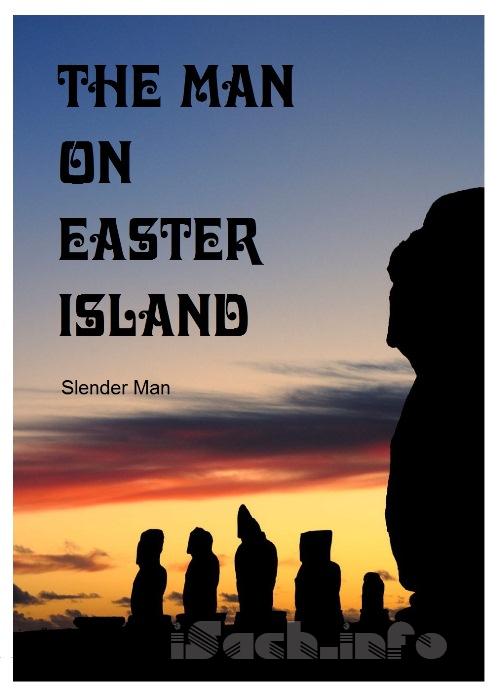***
It’s just a legend.
But…I suppose…that’s what most of those unbelievable things turn out to be…legends.
I heard this legend from my grandmother. I asked her about it when I saw her drawing the Easter Island heads on a piece of construction paper. Actually, when she found out that my dad never told it to me, she was a bit upset…I guess it’s family tradition. She even made me promise to tell it to my children. My grandma originally heard it from her mother, who heard it from her mother…well, you know how these things work. It goes back in my family for as long as anyone can remember. You see, if you trace back my family far enough, you’d never leave the United States. The earliest official records of my family say that we started in Hawaii, but according to my grandma, we actually started out on anisland in the southern Pacific Ocean: Easter Island (or, as my grandma ordered me to call it, Rapa Nui). That’s where this legend comes from—supposedly unaltered, exactly the way it was told centuries and centuries ago.
According to the legend, the people on Rapa Nui had always been in touch with the spirits. They had their ceremonies, they did their fair share of sacrifices, etc. Sure, these days the idea of sacrificing an animal to a god seems a bit crazy, but keep in mind that it was normal back then. It was all they knew; the civilization had worshiped the spirits that they believed walked among them since the dawn of time. (Well, actually, I should say “flew”…apparently, the spirits that my wise ancestors worshiped were actually giant, creator bird people. Not that I’m judging or anything.)
But then, after hundreds of years of the same traditions, the same ceremonial rituals, the same chants, the same animal sacrifices…something changed. The people started to see something. Every once in a while, someone would report seeing a man standing by them in the night. Occasionally, he stood at the edge of the forest and “watched” the people who dared to walk by alone. He could be seen in the shadows, in the water, in the trees, or even in the grass. Regardless of where he was or who saw him, though, he always looked the same. He was reportedly very tall and covered in wrinkly, dark grey skin. He had a long, almost rectangular head, but where his eyes should have been, he had two deep, smooth depressions surrounded by shadows. His giant nose was also rectangular, and the bridge sunk back into the shadows along with the eye sockets. His mouth, stretched into a long, dark frown, rested above a square chin. His arms were short compared to the rest of his body. They were nothing but stubs, but when he moved them, it seemed that he had at least 10 joints. (I asked my grandma if she meant like tentacles–she said no, because tentacles flow, and the man’s arms were rigid and stiff.) Apparently, he had two legs, like any human, but they curled up and contracted like a worm until they were inside him. He didn’t need legs, my grandma said, to be tall.
The first time somebody saw the man, the village thought he was insane. He talked nonstop about this man that only he could see. He tried to describe the mysterious figure and insisted that it was familiar to all of them, that they’d all seen it before, dozens of times. No one could understand the descriptions of the man, though. A week passed, and the man from the village saw the strange being (who, from now on, I will refer to as the Mo’ai) more and more frequently. But the more he tried to explain to his family what the Mo’ai looked like, the less they understood what he meant. Then, exactly a week after first seeing it, the man was found dead where he slept. The Rapa Nui people thought that their gods had struck him down for blasphemy, and they chose to never speak of him or the Mo’ai again. However, about two weeks later, another member of the village claimed to have seen the Mo’ai one night. She said that he didn’t watch her, but simply stood over her, staring straight forward into the darkness. However, she also mentioned how the man who saw it before was absolutely right–now that she saw it, she knew it. She had known its face, with its sunken eyes, its pointed nose, its bald, wrinkled head, and its eternally closed mouth. The villagers thought that she had gone mad as well, and ignored her as she described the Mo’ai to them. A week after she first saw it, she, too, was found dead. She had eaten a poisoned berry by mistake.
The people of Rapa Nui kept on seeing the Mo’ai, and everyone who saw it died seven nights later. It wasn’t like a plague, though. It wasn’t like the Mo’ai would appear to people, therefore condemning them to death. It seemed that those who saw it would have died anyway—it was more of a warning than a sentence. And each time someone saw it, they would realize that they knew its face like they knew the camp in which they lived, like it had always been there, and they just didn’t realize until they saw it. But the people who couldn’t see the Mo’ai swore that they had never seen anything like what those who could were describing before. But one thing about the clan’s attitude towards the Mo’ai did eventually change: the chief decided that it was an evil spirit who appeared to those who were to die.
One man who saw the Mo’ai got so frustrated that no one knew what it looked like that he decided to carve it out for his fellow villagers to see. He made it out of the tallest boulder he could find, and he carved the omen exactly as he saw it. But the Rapa Nui people, upon looking at the effigy, held that they had never seen the thing before. The man who carved the statue was so angry that he took one of the stone tools that he had used to carve the statue and sliced his throat open (at this point, I silently decided never to tell this story to my children). He ended his own life exactly one week after he first saw the Mo’ai.
Then, something terrible happened. I guess you could call it genocide, but it’s not like you’d expect. You see, the clan’s chief demanded to know what the Mo’ai really looked like. If everyone who saw the Mo’ai recognized it, then they should have recognized the statue, too. But they didn’t, so they needed another skilled carver to see the Mo’ai and make as many statues as he could. And here’s the terrible, genocide-ish part. The natives came up with an idea: everyone who knew how to carve stone was to kill themselves in a week. That was the plan. The plan was for the carvers to plan to kill themselves. Well, it worked, and they produced quite a few statues out of it. But by the time that the workers ended their lives, the chief looked upon the statues that had been produced and saw that they were all identical to the original. So he ordered more people to kill themselves. Not enough people volunteered, so he sought help from other clans on Rapa Nui. None of the others had heard of the strange Mo’ai creature that the messengers talked about, but after someone from the first tribe visited another tribe, then people from that new tribe began to see it too. Suddenly, it was an island-wide disaster, and every craftsman on Rapa Nui was ordered to be executed in seven days. It worked, and every craftsman began seeing the Mo’ai. They carved it into the boulders to prove what it looked like, but they were still almost exactly the same, and still no one knew the face.
My grandma said that the mass homicides and suicides went on for almost a year, until finally every chief, all at once, saw the Mo’ai. They realized that the people they had killed had really been carving the statues perfectly the entire time. They stopped ordering deaths of stone carvers, but that didn’t stop the uprising all across the island that took the life of every chief.
That’s where the legend part stops, I’m afraid. Because the people of the island stopped carving the statues after that, and a few hundred years later, the Europeans arrived. They were a bit surprised by the statues (which, by the way, had since been positioned along the shoreline in hopes of frightening away any more dark spirits). They figured that the statues of the Mo’ai were simply erected in honor of the Rapa Nui ancestors. It wasn’t until one of the settlers started seeing the Mo’ai that they realized what the statues were. They thought that the Rapa Nui natives had summoned the evil spirit by building the statues, and they tried tearing down them down. It obviously didn’t work.
I asked my grandma what happened next; I mean, obviously people who visited Rapa Nui didn’t still see the Mo’ai when they were about to die, did they? She told me that it only ever appeared to the people who currently lived on the island and to direct descendants of the original island natives. Visitors weren’t haunted by it. I asked her if I would see it when it was time for me to die, since she had just told me that I was a direct descendant of the Rapa Nui natives. She just smiled and laughed quietly as if I had just told a joke.
Then, I asked her why no one knew about this legend. I mean, if the Mo’ai still appeared to some people, don’t you think they’d want to tell someone? She told me that the locals know not to make a big deal out of it. The more they talk about the Mo’ai, the more often it appears to them. She said that some people went mad if they didn’t talk about it, though. Apparently, the fact that no one understands exactly how familiar the Mo’ai is until they see it is almost too frustrating to handle. Sometimes, it’s so unbearably maddening that its victims end up killing themselves (making me wonder exactly how true my statement about how the Mo’ai doesn’t condemn people to death by appearing to them really was). But people find their own ways to deal with it during their last week of life. Some people travel to Rapa Nui to see the ancient statues. Some people make their own mini sculptures of the creature. Some people simply draw the Mo’ai on paper, just to make it easier to deal with the stress.
My grandmother died four days later.
Credit To – Christopher Gideon



 ePub
ePub A4
A4